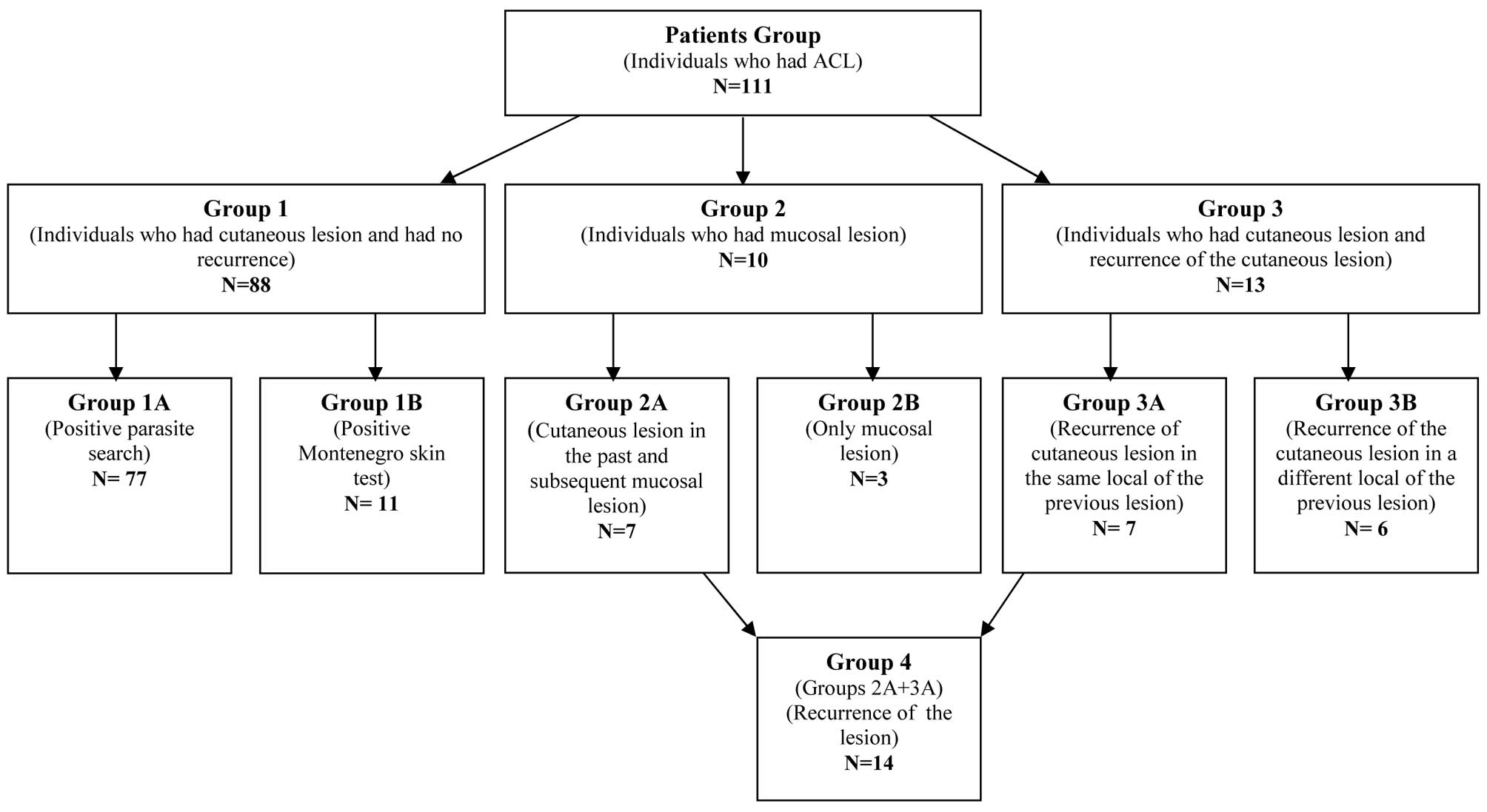|
1
|
Rey L: Leishmania and leishmaníases:
parasites. Parasitology, Editora Guanabara Koogan. 3rd edition. Rio
de Janeiro: pp. 214–226. 2001
|
|
2
|
Condino MLF, Galati EAB, Holeman MM, Salum
MRB, Silva DC and Junior RAN: American cutaneous leishmaniasis on
the northern coastline of São Paulo, 1993 to 2005. Rev Soc Bras
Trop Med. 41:635–641. 2008.(In Portuguese).
|
|
3
|
Gontijo CMF and Melo MN: Visceral
leishmaniasis in Brazil: current status, challenges and prospects.
Rev Bras Epidemiol. 7:338–349. 2004.(In Portuguese).
|
|
4
|
Gontijo B and de Carvalho Mde L: American
cutaneous leishmaniasis. Rev Soc Bras Med Trop. 36:71–80. 2003.(In
Portuguese).
|
|
5
|
Pan American Health Organization.
Leishmaniasis: 2007 update. http://www.paho.org/English/AD/DPC/CD/leish-2007.pdf.
Accessed Feb 09, 2012
|
|
6
|
Guerra JAO, Barbosa MGV, Loureiro ACSP,
Coelho CP, Rosa GG and Coelho LIACR: American cutaneous
leishmaniasis in children: epidemiological aspects of cases treated
in Manaus, Amazonas, Brazil. Rep Public Health. 23:2215–2223.
2007.(In Portuguese).
|
|
7
|
Lima AP, Minelli L, Teodoro U and
Comunello E: Distribution of cutaneous leishmaniasis by orbital
remote sensing images, in Paraná State, Brazil. An Bras Dermatol.
77:681–692. 2002.
|
|
8
|
Brasil: Ministério da Saúde: Vigilância
Epidemiológica. 2012, http://portal.saude.gov.br/portal/saude/profissional/area.cfm?id_area=1560.
Accessed Feb 09, 2012
|
|
9
|
Alexander J and Bryson K: T helper
(h)1/Th2 and Leishmania: paradox rather than paradigm. Immunol
Letters. 99:17–23. 2005. View Article : Google Scholar : PubMed/NCBI
|
|
10
|
Abbas AK: Cytokines. Cellular and
Molecular Immunology. Abbas AK, Lichtman AH and Pillai S: 6th
edition. Elsevier; Rio de Janeiro: pp. 267–302. 2008
|
|
11
|
Murphy PM: The molecular biology of
leukocyte chemoattractant receptors. Annu Rev Immunol. 12:593–633.
1994. View Article : Google Scholar : PubMed/NCBI
|
|
12
|
Baggiolini M: Chemokines and leukocyte
traffic. Nature. 392:565–568. 1998. View
Article : Google Scholar : PubMed/NCBI
|
|
13
|
Proost P, Wuyts A and van Damme J: The
role of chemokines in inflammation. Int J Clin Lab Res. 26:211–223.
1996. View Article : Google Scholar
|
|
14
|
Pereira AB, Rezende NA, Teixeira AL Jr, et
al: Cytokines and chemokines in renal transplantation. J Bras
Nefrol. 31:286–296. 2009.(In Portuguese).
|
|
15
|
Spagnolo P, Renzoni EA, Wells AU, et al:
C-C chemokine receptor 5 gene variants in relation to lung disease
in sarcoidosis. Am J Respir Crit Care Med. 172:721–728. 2005.
View Article : Google Scholar : PubMed/NCBI
|
|
16
|
Guignard F, Combadiere C, Tiffany HL and
Murphy PM: Gene organization and promoter function for CC chemokine
receptor 5 (CCR5). J Immunol. 160:985–992. 1998.PubMed/NCBI
|
|
17
|
Liu R, Paxton WA, Choe S, et al:
Homozygous defect in HIV-1 coreceptor accounts for resistence of
some multiply-exposed individuals to HIV-1 infection. Cell.
86:367–377. 1996. View Article : Google Scholar : PubMed/NCBI
|
|
18
|
Yang X, Ahmad T, Gogus F, et al: Analysis
of the CC chemokine receptor 5 (CCR5) Delta32 polymorphism in
Behçet’s disease. Eur J Immunogenet. 31:11–14. 2004.
|
|
19
|
Sidoti A, D’Angelo R, Rinaldi C, et al:
Distribution of the mutated delta32 allele of the CCR5 gene in a
Sicilian population. Int J Immunogenet. 32:193–198. 2005.
View Article : Google Scholar : PubMed/NCBI
|
|
20
|
Chies JA and Hutz MH: High frequency of
the CCR5delta32 variant among individuals from an admixed Brazilian
population with sickle cell anemia. Braz J Med Biol Res. 36:71–75.
2003. View Article : Google Scholar : PubMed/NCBI
|
|
21
|
Zúñiga JA, Villarreal-Garza C, Flores E,
et al: Biological relevance of the polymorphism in the CCR5 gene in
refractory and non-refractory rheumatoid arthritis in Mexicans.
Clin Exp Rheumatol. 21:351–354. 2003.PubMed/NCBI
|
|
22
|
Fildes JE, Walker AH, Howlett R, et al:
Donor CCR5 Delta32 polymorphism and outcome following cardiac
transplantation. Transplant Proc. 37:2247–2249. 2005. View Article : Google Scholar : PubMed/NCBI
|
|
23
|
GenBank. http://www.ncbi.nlm.nih.gov/nuccore/AF009962.
Accessed Apr 05, 2010
|
|
24
|
Silveira TG, Arraes SM, Bertolini DA,
Teodoro U, et al: The laboratory diagnosis of epidemiology of
cutaneous leishmaniasis in Paraná State, southern Brazil. Rev Soc
Bras Med Trop. 32:413–423. 1999.(In Portuguese).
|
|
25
|
Galvani AP and Novembre J: The
evolutionary history of the CCR5-Delta32 HIV-resistance mutation.
Microbes Infect. 7:302–309. 2005. View Article : Google Scholar
|
|
26
|
Stanford Medicine Schoool. http://www.thetech.org/genetics/news.php?id=13.
Accessed Feb 12, 2012
|
|
27
|
Lamb A: CCR5-delta32: a very beneficial
mutation. J Creation. 20:152006.
|
|
28
|
Pereira AB, Rao NA, Teixeira AL Jr,
Teixeira MM and Silva ACS: Cytokines and chemokines in renal
transplantation. J Bras Nefrol. 31:286–296. 2009.(In
Portuguese).
|
|
29
|
Li H, Xie HY, Zhou L and Zheng SS: Lack of
association of the polymorphism of the CCR5 gene in liver
recipients with acute rejection from China. Exp Clin Transplant.
9:252–257. 2011.PubMed/NCBI
|
|
30
|
Oliveira KB, Reiche EMV, Morimoto HK, et
al: Analysis of the CC chemokine receptor 5 delta32 polymorphism in
a Brazilian population with cutaneous leishmaniasis. J Cutan
Pathol. 34:27–32. 2007. View Article : Google Scholar : PubMed/NCBI
|
|
31
|
Muxel SM, Borelli SD, Amarante MK, et al:
Association study of CCR5 delta 32 polymorphism among the HLA-DRB1
Caucasian population in Northern Paraná, Brazil. J Clin Lab Anal.
22:229–233. 2008.PubMed/NCBI
|
|
32
|
Passos GA Jr and Picanço VP: Frequency of
the delta CCR5 deletion allele in the urban Brazilian population.
Immunol Lett. 61:205–207. 1998. View Article : Google Scholar : PubMed/NCBI
|
|
33
|
Leboute AP, de Carvalho MW and Simões AL:
Absence of the deltaCCR5 mutation in indigenous populations of the
Brazilian Amazon. Hum Genet. 105:442–443. 1999. View Article : Google Scholar : PubMed/NCBI
|
|
34
|
Martinson JJ, Chapman NH, Rees DC, Liu YT
and Clegg JB: Global distribution of the CCR5 gene 32-basepair
deletion. Nature Genet. 16:100–103. 1997. View Article : Google Scholar : PubMed/NCBI
|
|
35
|
Brasil. Ministério da Saúde. Manual de
vigilância da leishmaniose tegumentar Americana. Brasília, DF: pp.
1812007
|











